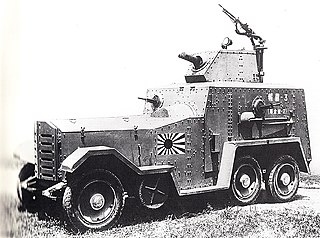
The Type 94 tankette (Japanese: 九四式軽装甲車, Kyūyon-shiki keisōkōsha, literally "94 type light armored car", also known as TK that is abbreviation of "Tokushu Keninsha" that means special tractor was a tankette used by the Imperial Japanese Army in the Second Sino-Japanese War, at Nomonhan against the Soviet Union, and in World War II. Although tankettes were often used as ammunition tractors, and general infantry support, they were designed for reconnaissance, and not for direct combat. The lightweight Type 94 proved effective in China as the Chinese National Revolutionary Army had only three tank battalions to oppose them, and those tank battalions were equipped only with some British export models and Italian CV-33 tankettes. As with nearly all tankettes built in the 1920s and 1930s, they had thin armor that could be penetrated by .50 caliber machine gun fire at 600 yards range.

An armoured train is a railway train protected with armour. Armoured trains usually include railroad cars armed with artillery, machine guns and autocannons, some also had slits used to fire small arms like pistols and rifles from the inside of the train, this feature was especially prevalent in earlier versions of armoured trains. For the most part they were used during the late 19th and early 20th centuries, when they offered an innovative way to quickly move large amounts of firepower. Most countries discontinued their use – road vehicles became much more powerful and offered more flexibility, and train tracks proved too vulnerable to sabotage as well as to attacks from the air. However, the Russian Federation used improvised armoured trains in the Second Chechen War of 1999–2009.

The Special Naval Landing Forces (SNLF), were the marine troops of the Imperial Japanese Navy (IJN) and were a part of the IJN Land Forces. They saw extensive service in the Second Sino-Japanese War and the Pacific theatre of World War II.

The Type 88 75 mm AA gun was an anti-aircraft gun used by the Imperial Japanese Army during the Second Sino-Japanese War and World War II. The Type 88 number was designated for the year the gun was accepted, 2588 in the Japanese imperial year calendar, or 1928 in the Gregorian calendar. It replaced the earlier Type 11 75 mm AA gun in front line combat service, and at the time was equal in performances to any of its contemporaries in western armies and was considered capable of handling any targets the Japanese army was likely to encounter on the Asian mainland. Although it was soon overtaken by improvements in aircraft technology and was largely obsolete by 1941, it continued to be used on many fronts until the end of the war.

The Type 95 Ha-Gō was a light tank used by the Empire of Japan during the Second Sino-Japanese War, at Nomonhan against the Soviet Union, and in the Second World War. It proved sufficient against infantry but, like the American M3 Stuart light tank, was not designed to combat other tanks. Approximately 2,300 were produced, making it the most numerous Japanese armoured fighting vehicle of the Second World War.

The Marmon-Herrington Armoured Car was a series of armoured vehicles that were produced in South Africa and adopted by the British Army during the Second World War. RAF Armoured Car companies possessed them, but seem never to have used them in action, making greater use of Rolls Royce Armoured Cars and other types.

The Type 92 Heavy Armoured Car, also known as the Type 92 cavalry tank, was the Empire of Japan's first indigenous tankette. Designed for use by the cavalry of the Imperial Japanese Army by Ishikawajima Motorcar Manufacturing Company, the Type 92 was designed for scouting and infantry support. Although actually a light tank, it was called sōkōsha in Japanese due to political sectionalism within the Japanese Army. Exactly the same device was used in America with the M1 Combat Car.

This article deals with the history and development of tanks of the Japanese Army from their first use after World War I, into the interwar period, during World War II, the Cold War and modern era.

The Type 93 Armoured Car (九三式装甲自動車) was an armoured car used by the Empire of Japan both before and during World War II.

The Sumida M.2593 was an armoured car produced in Japan in the 1930s. It could operate on both the roadway and railway lines.

The Chiyoda armored car was the first domestic Japanese armored car which was officially introduced by the Imperial Japanese Army (IJA) and produced in the 1930s.
Reconnaissance regiment in Japanese language, was the type of the military establishment within Imperial Japanese Army in the 1940-1945 period. Reconnaissance regiment was the type of unit derived from Cavalry regiment, tasked with combat scouting. In Japanese military literature reconnaissance regiment is usually abbreviated by SO letters. These regiments were attached to the large number of the Japanese division at the opening stages of the Pacific War. In modern Japan, these regiments are equivalent to Reconnaissance battalion in the divisions of the Japan Ground Self-Defense Force.












